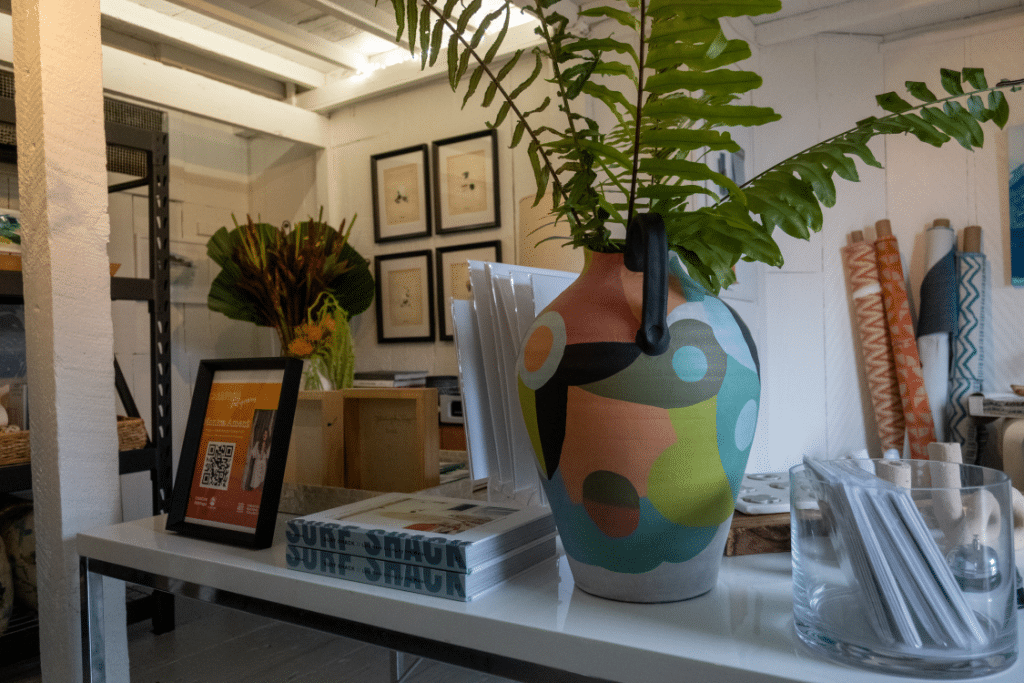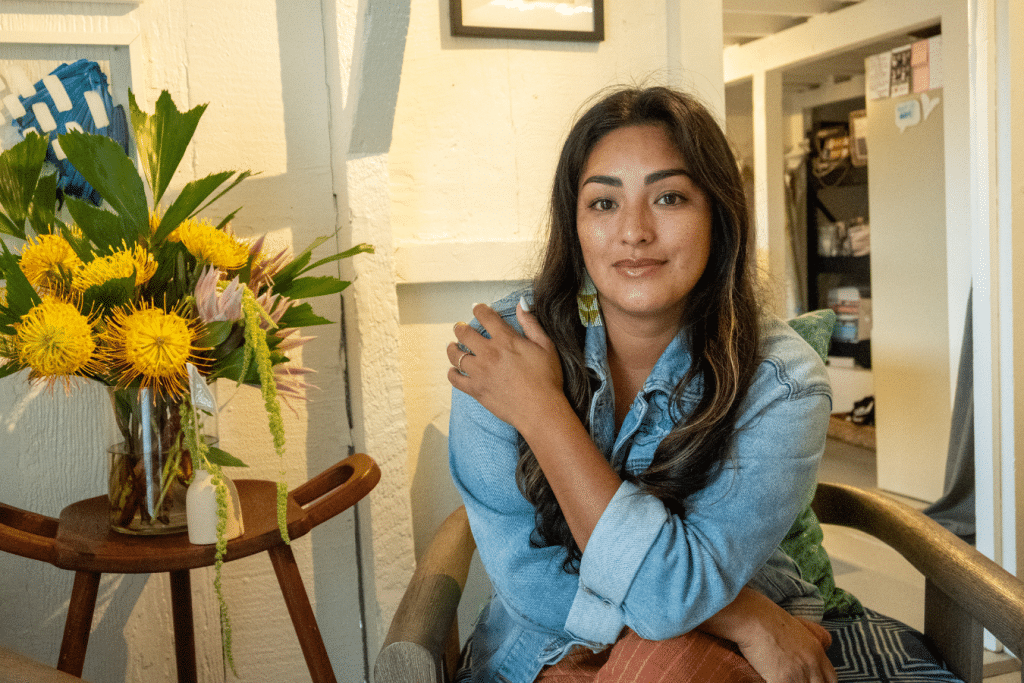Select a subscription plans
You need a subscription to access this content.
Monica Ament grew up in a small home with a big family, where personal space and organization were a challenge. When she finally had a home of her own, she thought of ways to make it feel safe, which she added earthy colors, beautiful art, and plants with a comfortable bed finished with soft, natural lighting. This made a lightbulb go off in Ament’s head, which inspired her to focus on designing healthy living spaces. “Everybody’s personal safe space is different from me to you,” she explained. “That’s where good design comes in.” According to Ament, a good Interior Designer thinks about the client’s personal taste, cultural background, life experiences, and family and children, not their own. “So every space is different because everybody is unique and different.”
Now, Ament designs both interiors and exteriors with a creative and sculptural flair and is renowned for designing beautiful yet functional spaces. She also cultivates her signature version of Big Island style. Ament incorporates an authentic island experience into her design, giving a straight-from-the-beach feel to any of her projects. You’ll find coastal color schemes, ocean elements, and beach decor in her work; stepping into any space that Ament either designed or remodeled feels like a tropical retreat.

With her new design studio and boutique opening and list of clientele expanding, Ament is positioning herself to become a top Interior Designer of Hawai’an Interior Design.
Here, Ament discusses her design journey and how she’s carving out her own path within the industry while supporting local artisans and businesses.
KH: Could you share a little bit about yourself with our readers?
Ament: My name’s Monica Ament. I am multicultural. My tribes are Navajo and Laguna Pueblo. I live here on the Big Island in Holualoa, where my boutique is. This is where I call home, and this is my new space. I’m a designer. I’m creative; I love to do all kinds of art and make music. I’m a mother of two beautiful children and a wife, so that keeps me busy. I love to snowboard, surf, bodyboard, and longboard. Those are some hobbies I like to do outside of my creative business and work. So music, being out in nature, getting dirty and having fun, that’s what I like to do.
KH: How do you balance that with being a mother and a wife, an entrepreneur, and taking care of yourself?
Ament: It’s a constant balancing act. It’s a puzzle and a balance game of how my day should roll. Obviously, my kids come first, so I let that take the lead. That takes priority because mom is my biggest job. Then whatever time I have left is what I devote to my business and my new boutique. It’s also my passion, so I prioritize that as much as possible. Any parent out there knows that it’s a constant balancing act. One person might wake up sick, or the other person might have a field trip, or something happens with my client, and a house has to get installed. It’s constantly changing it up every single day and letting you know what takes priority. It’s never the same every day.
KH: Could you explain to our readers what interior design is?
Ament: Design is creating a space that is functional and beautiful and helps you live your life. That your everyday life and all of the memories you make, that’s the space designed around all of those–making breakfast, doing laundry, sleeping in a comfortable, safe bed, having a birthday party, simple tasks. That’s what I use as my momentum and priority. When I think about designing a space, not only does it have to take priority to be beautiful, but it also has to serve a function or multi-functions. As you know, we move into this new age of designing for multiple spaces–your house, your living room, and your workspace. Your linen closet can also be somebody’s home music studio. Sometimes homes have to serve more than one function, and I think the fun and challenging part is working with small spaces.

KH: What inspired you to become an interior designer?
Ament: Being a creative person and my cultural upbringing, and the places I’ve lived inspired me to take this path of designing and creativity. I was born in Oakland, California, and some of my earliest memories are of my grandmother. She had this beautiful historical old Victorian home, and I remember being in awe of how beautiful and ornate this home was. That sparked my attention. I was constantly drawing homes and furniture, mostly homes. That was one of my first memories of being interested in homes and architecture.
Also, growing up in a really small, tiny house where it was constantly chaotic and lacked space and organization, even though I came from a loving home, it was also really challenging to live in. A one-bedroom home with six kids and two parents and animals and all kinds of things, so it was challenging. It lit a fire in me, with my own personal home and my own personal space. How I want to live my life when it came time to make my own decisions and create my own safe space; having those things combined lit a fire in me to start this path of design and creating healthy living spaces.
KH: When did you realize you wanted to do interior designing as a profession or a career?
Ament: It was when I had finished high school, and here on the big island, I was working for a locally owned business by Diane Kaha. She was a woman and an entrepreneur who owned her own business. She had a lighting company, so that’s where I started on that path of design and architecture through lighting. Here’s a strong woman who owns her own business, makes her own schedule, that’s still having babies and doing all of this in this beautiful town and working with all these contractors. She was a force, and I gravitated to her. She took a chance on me, and I started doing lighting, and that pushed me in that path of design. I wasn’t sure at that time if I wanted to be a lighting specialist, but I knew that this was the realm in the field that I wanted to be in. I give my hat off to her. I always think about her when it’s time for me to take it to the next step. I always go back to that point in my life and reflect on working for her because she really was someone I looked up to. So thank you, Diane Kaha.
KH: Could you explain the science and math that goes with interior design?
Ament: Space planning is really what it comes down to. Creating a well-designed space first starts with measurements and natural light. Taking into account the bones of the architecture of a space. Maybe it’s a building, or maybe it’s a structure outside, so take into account of natural lighting measurements of your room. That’s where you go into nitty-gritty details with measurements, space planning, and everything. It starts with measuring everything, making sure it’s ergonomically correct for someone’s body. Especially for me, walking into my small little space. Some people are taller, and some people are smaller. Some people need more supportive arms for their chairs because they might have a mobility issue where they have to stand up and support themselves, so make sure things are sturdy and comfortable; the right seat height so that it’s ergonomically correct for your body and designed for that. Most people don’t know a dining table is typically the same height. A chair height is typically around the same height, and it’s because it’s designed specifically for the body as opposed to being just for looks.

KH: How does space–whether living, personal or work–influence their life or how they feel?
Ament: There are so many things that go into a space and how they can make someone feel. That’s the whole purpose of design. You could have a hospital that is designed to make someone feel comfortable, relaxed, calm, and clean, whereas you can design another home that is made to be exciting, vibrant, and bold, or sultry, dark, and moody. You can change a space based on its color or the finishes. Do you want a big comfy sofa that engulfs you in a hug, or do you need to create a courthouse-style room where everything is stiff and cold for everybody to be focused and not stay put there for too long? Everything between color, finishes, fabrics, texture, and lighting goes into the whole grand scheme and how that can affect oneself.
KH: So, what is your process like when designing a space?
Ament: It always starts with an initial meeting where I get to know the client and their personal life, unique needs, and wants. It starts with an interview, getting to know somebody if I have a connection with that person or not, because the process is a relationship and it’s a long, sometimes lengthy process, so you have to enjoy working with your client just as much as they enjoy working with you. Sometimes, if you’re not happy in that working relationship, things start to get tough. You have to make sure you have a great foundation to work with somebody, that you’re excited to work with them, and that you have good boundaries. That would be the first start of the process is getting to know my client.
The second is going to the actual space we’re designing, taking into account the structure of the building itself because we could dream up exactly what we want for our home, but it might not be right for the building they’re in. I always go to the job site itself, and I take measurements. Everything I take into account is all of the windows and natural light and the materials that we would be using. Then that’s where I start–my presentations, specifications, and selections for the whole project. We go back and forth a couple of times, editing and deleting items and adding new ones until we come to beautiful designs from start to finish. Then orders happen after that, and the rest is history after the orders, so that’s the process.
KH: What are some of the challenges that you go through?
Ament: Working with multiple opinions and ideas. A lot of the time, it’s like you’re a therapist in between a couple working with different needs and wants. One husband might love dark, moody colors, and his wife might love pastels, then finding a happy marriage between those two that compliments both are challenging. Working with the instantaneous culture that’s happening now, you can click a button on the internet, and boom here pops up a package from Amazon four days later. I think that has changed the idea of how long it takes to procure these items and order the correct thing. The instantaneous culture has made it challenging for me personally because everything good takes time. You want the correct chair with the right fabric; it’s going to take some time for someone to order that and have it delivered and handmade and then packed up and shipped across the ocean. That is very challenging. The tracking and the ordering part is not challenging; it’s just the waiting time, and having patience is more of the challenging part.
KH: How does your heritage or culture influence your design and decorating?
Ament: It has everything to do with how I approach everything in my life. I’m a multicultural lady, so I have so many things that I pull from; so many things that I like that ring true to me but might not necessarily ring true to other people. I always think about the land that a home is built on first and foremost: what are its natural surroundings? Who are the Indigenous people that are from there? How do you honor it in a way that is not cultural appropriation? How do you utilize Hawai’an or local artists to help support your community? Those are the things that I always think of first and foremost when I go into a project. How many hands can I pull into this project that’s going to directly affect the people that live here and that are from here? How do I do it in a way that’s helping and not hurting? So it’s a balancing act for me. Most of my clients are second homeowners. They’re originally from the mainland, and they’re buying homes here when a lot of the people that are born and bred here don’t have the opportunity to do that. So it’s my responsibility to be able to help bring them on board and help support the community if they’re not able to do that themselves. Knowing that I’m supposed to be supportive of Indigenous people has driven my selection of artisans and wood makers.

KH: Going back to you talking about how you want to impact people and bring as many people into a project, how do you specifically work with other small businesses?
Ament: I recently did a presentation where it talks about how I utilize my own cultural beliefs and how that impacts my own design and personal style. One of those things is to find your tribe, and that’s working with people you vibe with that are on the same page as you and have the same morals. If you have to work together and you are all on the same page, things work a lot easier as opposed to if you work with somebody that doesn’t understand your own cultural background; it’s hard because sometimes there’s a disconnect.
KH: Anything else that you get from other small businesses around here in Hawai’i?
Ament: One of my main focuses is sourcing locally. Before I go out and order something online or through my outside vendors, I always look at local businesses and how I could support their businesses here first. Going back to supporting your community part, I think that’s so important. Sure, I can order my fabric, but I’m going to use the local upholsterer. Sure, we can find some beautiful art online, but there are plenty of amazing local artists here that I could use, but their art shows the nature of this place that compliments the home more. I do a lot of beach homes, tropical homes, and big island homes. So what does that entail? The ocean life, natural surroundings, plants, and trees found here.
I utilize lots of local artisans and fabricators. It creates a good relationship. We all are in a network together, and it’ll pay itself forward at some point; you help somebody else, and that is going to help you, too, later on in the long run. That’s where I start first with supporting locals.
KH: So, what is your business looking like now?
Ament: It’s going so well because I’ve had so many amazing referrals and focused on sourcing local and working with local people–realtors and property managers; I’ve created those relationships that helped create this great referral line for me. Business is great. I have plenty of projects that I’m finishing up now and some new ones that I’m going to be starting up this spring. I never had my calendar like this before, which is really exciting for me. I don’t have to be worried about having to go out and get my business. It’s starting to come back to me, and I don’t have to reach out for it. I’m really happy.
KH: Is there anything else you’d like to share with our readers?
Ament: In a perfect world, we have a big beautiful home that we own ourselves. In a perfect world, we have a budget that’s huge, and we can buy anything we want; but we don’t live in a perfect world, and we should work with what we have and be grateful for the things that we do have. Start in your own home. If you have a space that is driving you crazy or you feel is bringing you down and want to be uplifted, start there first. By eliminating the chaos, start by getting yourself organized so you could have a clear space to think and rest. You don’t have to have a multimillion-dollar home to be in love with your space. You can utilize what you have and make that your safe space. If you find yourself in a chaotic world and need to come home and unwind, start first with where you sleep and your main common spaces and declutter. Start there first before you add anything because you can buy all of the accessories in the world, but it’s going to clutter your space. Eliminate first before you add; those are my tips for staying organized.











